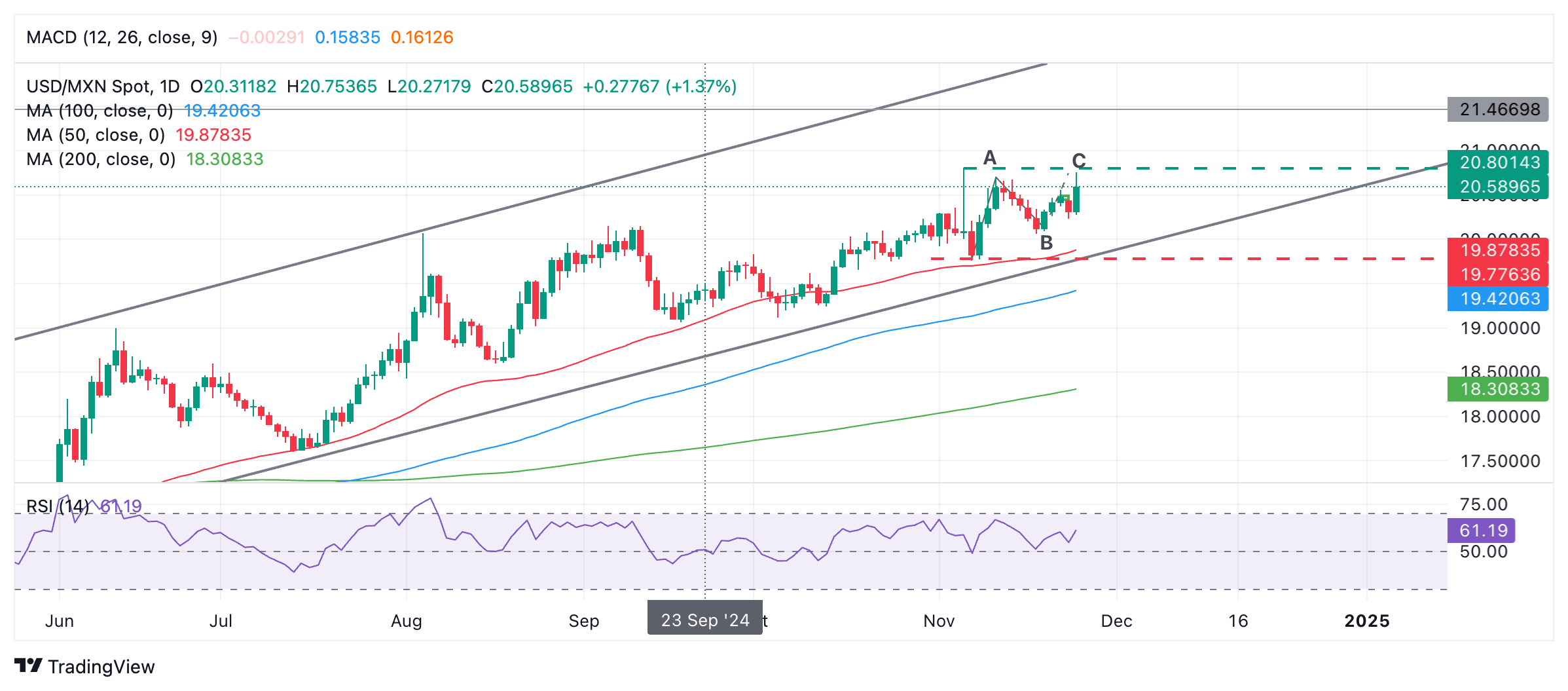Mexican Peso plummets on Trump tariff threat
- The Mexican Peso slides into a ravine after Donald Trump threatens to slap 25% tariffs on Mexican imports.
- The Peso faces further pressure from expectations that Banxico will start cutting interest rates more aggressively due to easing inflation.
- Technically, USD/MXN rallies to the top of a mini range within which it oscillates in the short term.
The Mexican Peso (MXN) declines by an average of one and a quarter percent in its most-traded pairs on Tuesday after President-elect Donald Trump said he would place a 25% tariff on goods entering the US from Mexico and Canada unless the countries reduced illegal migration and the cross-border traffic in illicit drugs. Trump's threat was mainly aimed at Mexico, where powerful cartels manufacture Fyentanol before smuggling it across the border into the US.
The MXN weakened to 20.75 Pesos to one US Dollar (USD) on the news, from a closing price of 20.31 on Monday. Mexico is one of the US’s largest trading partners, with imports from the country totalling $454.8 billion in 2022, up 18.9% ($72.2 billion) from 2021, according to the Office of the United States Trade Representative.
The imposition of tariffs of 25% would be expected to hurt demand for Mexican-made goods and for the Mexican Peso to purchase them.
Mexican Peso faces pressure from Banxico easing
The Mexican Peso is facing further pressure from market expectations that the Bank of Mexico (Banxico) could start to cut interest rates more aggressively in future meetings following a deceleration of inflation in November’s data. Lower interest rates are usually negative for a currency as they reduce foreign capital inflows.
Mexican financial daily El Financiero noted that the headline inflation rate fell to 4.56% year-over-year in the first two weeks of November. This was below the average of 4.65% based on a Bloomberg survey of analysts.
On Monday, the Peso made a brief but strong recovery against the USD on the news that Trump had picked hedge-fund manager Scott Bessent as his favorite for the post of US Treasury Secretary when he takes over in January.
The Dollar weakened on the news as Bessent is viewed as fiscally conservative and, therefore, likely to restrain spending, tempering the inflationary effects of Trump’s economic policy agenda. The Peso saw gains as Bessent was expected to predominantly target China with tariffs rather than Mexico or Canada.
Tuesday’s losses, however, more than erased the gains made on the first day of the week.
Technical Analysis: USD/MXN rises to top of mini range
USD/MXN rallies and fills the market gap opened on Monday.
The pair has now reached close to the top of the mini range (green dashed line on chart below) formed during November. This is also the C wave of a Measured Move pattern that has unfolded within the confines of the range. These patterns are like zig-zags in which waves A and C are of similar length.
USD/MXN Daily Chart

USD/MXN is probably range-bound in the short term as it oscillates between the 19.70s and 20.80s. In the medium and long term, however, it is still in an uptrend within a rising channel.
It would require a decisive break above the top of the range at 20.80 to signal the start of a more bullish short-term trend in line with longer-term up cycles.
In the absence of such a breakout, the pair is likely to continue to oscillate within the parameters of its range, with the next move probably back down towards the range floor in the 19.70s.
A decisive breakout higher would be one accompanied by a long green candle that pierced and rose well above the range highs, closing near its highs, or three green candles in a row that broke above the level.

